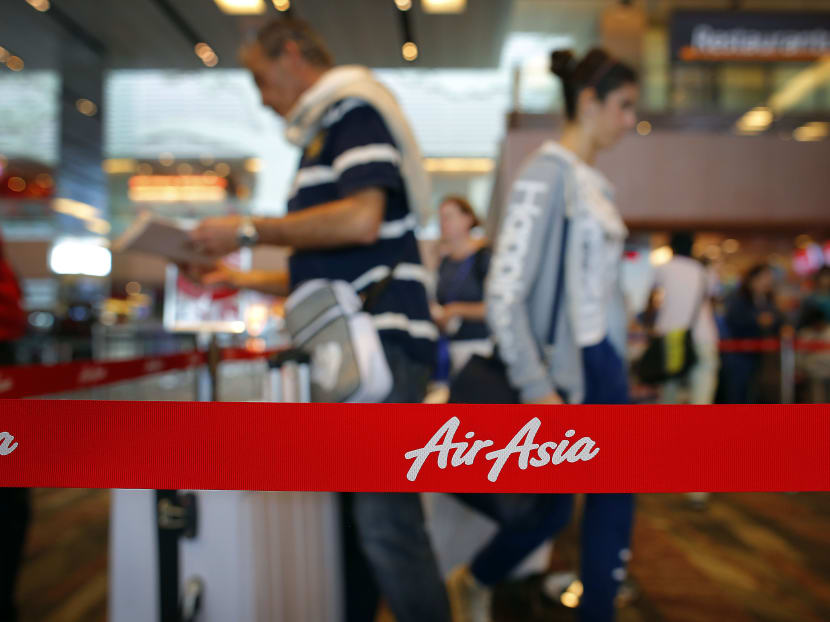AirAsia tapping on data as it goes digital
SINGAPORE — Drawing inspiration from disrupters like Grab, Uber and Amazon, low-cost carrier AirAsia is pulling out the stops to become a “digital airline” at the forefront of experimenting with new technology.
SINGAPORE — Drawing inspiration from disrupters like Grab, Uber and Amazon, low-cost carrier AirAsia is pulling out the stops to become a “digital airline” at the forefront of experimenting with new technology.
Over the next two years, it will roll out Wi-Fi, mobile payments and digital baggage tags with RFID tracking on all its flights in stages. Sensors will also be deployed to track the behaviour of cabin crew, and passengers’ movements to see how processes can be improved. Currently, these sensors have been installed on three aircraft. It is experimenting with technology that might be able to read passengers’ faces to determine their feelings, in order to help crew provide better service. Using data and machine-learning to better understand what passengers were prepared to pay for baggage fees, the airline is also looking to tailor the pricing to individuals.
“We begin to know what your tolerance level is for a certain ticket to a certain destination... We will charge you differently for baggage,” said AirAsia Group Chief Executive Officer Tony Fernandes.
Speaking at a media briefing on Thursday (Nov 16), he described data as “the new oil” and said he had been “blown away” by the valuation of digital companies.
“Uber is worth 10 times what we are. But actually our data is richer,” he said. “You begin to see how innovative these companies are, be it Uber, Grab or... Amazon. They really change the way you do things. And I thought, why can’t we bring that digital experience into airlines? And that began this journey.”
Installing Wi-Fi onboard would cost about US$350,000 per aircraft, but the airline declined to reveal the total amount of investments on its digital initiatives.
On going cashless in-flight, Mr Fernandes said cash “slows down everything”.
He said: “Very soon, you won’t have a trolley going down (the aisle in the plane). You order with your mobile phone, and it goes straight to the cabin crew, who will deliver the food to you. That’s already happening in the next two months, and we’ll giving each of our cabin crew a mobile device very soon.”
With its move to the new Terminal 4 (T4) at Changi Airport, AirAsia will also use data from its operations there to improve its airport processes. Insights from the data will be used across its entire group, said Mr Fernandes.
“Through collaboration with airports and government agencies, we want to improve operational, safety and commercial processes within the group by integrating multiple data sources,” he added.
As it taps on the Fast and Seamless Travel (FAST) system at T4, AirAsia said passengers will reap the benefits via lower fares. FAST initiatives include automated check-in kiosks, bag drops, immigration clearance and boarding gates powered by facial recognition technology. “The improved savings and efficiencies from FAST align perfectly with our quest to maintain the lowest cost structure as well as our vision of seamless travel,” said Mr Fernandes.
Aviation analysts lauded AirAsia’s efforts, noting that airlines are becoming more data-driven and going digital to keep up with the times.
Mr Shukor Yusof, from Endau Analytics, said: “I believe more airlines will probably go digital in the coming years... mainly because these are what passengers want or need, and for low-cost airlines such as AirAsia, this will also be another source of ancillary revenue for them.”
Flightglobal Asia Finance Editor Mr Ellis Taylor nevertheless said AirAsia appears to be “taking a bold step in taking a broad approach to implementing new technologies that may put it ahead of the game”.
But AirAsia’s advantage might be short-lived as many competitors are expected to hop on the bandwagon, he said.
The Malaysian carrier could also face challenges in introducing the initiatives across more cities, since not all airports have reliable data infrastructure. Its biggest challenge would be at its home base, he noted.
Mr Taylor said: “In the past, Malaysia airports did not allow AirAsia to use its automated check-in system at KLIA 2 (KL International Airport 2), and although that dispute is largely over, it may signal that the airport will be slow to allow the airline to roll out more advanced technologies.” He added: “That AirAsia is talking about new technologies at Changi Airport should be a wake-up call to Malaysia Airports to work with the carrier, rather than holding it up.”







